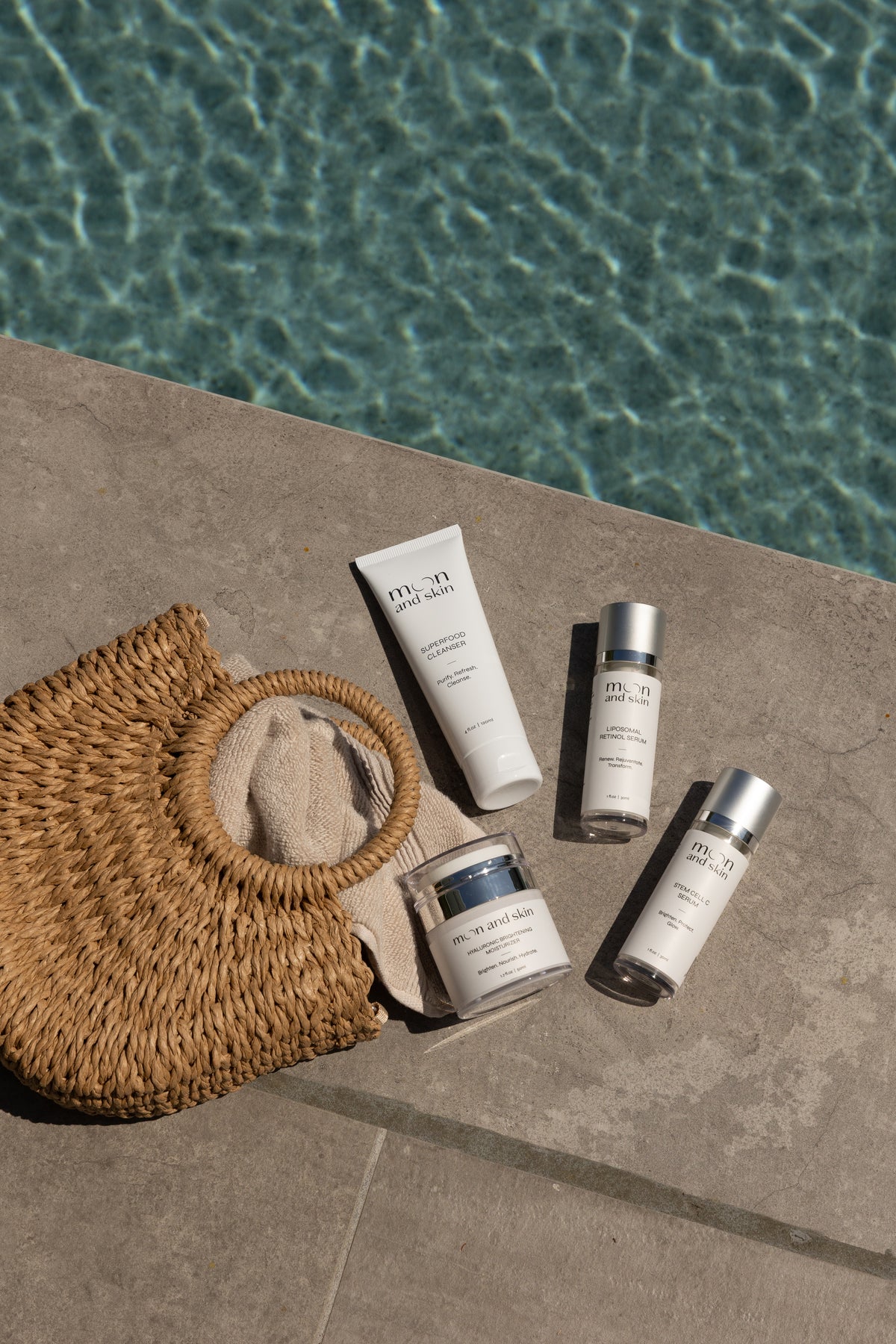Table of Contents
Introduction
Did you know that a staggering 31% of women reported having between six to ten skincare products in their beauty bags? This number likely reflects only the essentials they feel they can't live without, while many more products may be lurking in bathroom drawers and under sinks. With countless products available, the question of how many skincare products should you use becomes increasingly relevant.
Navigating the world of skincare can be overwhelming. We understand that it’s easy to feel pressured by social media influencers showcasing lengthy, multi-step routines—often featuring upwards of ten products! However, dermatologists and skincare professionals often emphasize that simplicity may be the key to achieving healthy, radiant skin.
In this blog post, we’ll explore how many skincare products are ideal for an effective routine, the importance of product layering, and how you can choose the right products for your unique skin type and concerns. Together, we will simplify your skincare journey and help you determine a balanced approach that suits your lifestyle and skin needs.
The Basics of Skincare Routines
Understanding Your Skin Type
Before diving into how many products you should use, it's essential to understand your skin type. Knowing whether you have dry, oily, combination, or sensitive skin will guide your product choices significantly.
- Dry Skin: If your skin feels tight, rough, or flaky, you might have dry skin. Those with dry skin often benefit from hydrating products.
- Oily Skin: If you notice your skin is shiny, particularly in the T-zone (forehead, nose, chin), you likely have oily skin. Lightweight, non-comedogenic products are ideal.
- Combination Skin: A mix of both dry and oily areas usually indicates combination skin. Tailor your products to address the specific needs of each area.
- Sensitive Skin: If your skin reacts easily to products or experiences redness, irritation, or burning, you may have sensitive skin. Look for gentle, hypoallergenic formulations.
The Essential Steps in a Skincare Routine
At its core, a basic skincare routine typically consists of four essential steps:
- Cleansing: This step is vital for removing dirt, makeup, and impurities. A good cleanser, such as our Superfood Cleanser, can help nourish your skin while cleansing.
- Moisturizing: Hydration is crucial for all skin types. Our Hyaluronic Brightening Moisturizer is designed to provide deep hydration while brightening your complexion.
- Sun Protection: Daily SPF application is non-negotiable. A broad-spectrum sunscreen protects against UVA and UVB rays, preventing premature aging and skin damage.
- Treatment Products: Depending on your skin concerns, you might want to incorporate treatment products like serums. For brightening and protection, our Stem Cell C Serum provides excellent antioxidant benefits.
Recommended Number of Products: The Experts Weigh In
While the beauty industry often promotes elaborate routines, experts generally recommend a more streamlined approach. Most dermatologists advise that a skincare routine can be effective with just three to four products. This typically includes a cleanser, moisturizer, and a targeted treatment or serum.
The Argument for Minimalism
Embracing a minimalist skincare routine can yield several benefits:
- Less Confusion: With fewer products, you can focus on what works best for your skin without the added stress of choosing from a multitude of options.
- Cost-Effective: Investing in quality products rather than an abundance of them can also save you money in the long run.
- Consistency: A simpler routine is easier to maintain, promoting consistency in application, which is vital for achieving desired results.
The Argument for Personalization
On the other hand, some individuals may find that their skin thrives with a more extensive routine due to specific concerns such as aging, acne, or hyperpigmentation. In this case, it’s essential to ensure that your products complement each other and are suitable for your skin type.
Layering Your Skincare Products
Understanding how to layer your skincare products is just as important as the number of products you use. Proper application ensures that each product performs effectively and penetrates the skin as intended.
The Correct Order of Application
- Cleanser: Start with our Superfood Cleanser to wash away impurities and prepare your skin for subsequent products.
- Toner (Optional): While not necessary for everyone, a toner can help balance pH levels and remove any leftover residue. Choose one suited to your skin type.
- Serum: Apply our Stem Cell C Serum or any other treatment serum next. Serums are concentrated and should be applied before heavier products.
- Eye Cream: The delicate skin around the eyes needs special attention. Invest in a dedicated eye cream for targeted treatment.
- Moisturizer: Follow with a moisturizer like our Hyaluronic Brightening Moisturizer to lock in hydration.
- Sunscreen: In the morning, finish with sunscreen to protect your skin from harmful UV rays.
Key Takeaways from Layering
- Always apply products from thinnest to thickest consistency.
- Allow each product to absorb fully before applying the next.
- Avoid mixing active ingredients unless recommended by a skincare professional.
Finding the Right Products for You
Identifying Your Skin Concerns
The ideal number of products can vary depending on your skin’s specific concerns:
- Aging: If you’re targeting fine lines and wrinkles, consider integrating products with retinol, like our Liposomal Retinol Serum, into your routine.
- Hyperpigmentation: Vitamin C and brightening serums can help. Our Stem Cell C Serum is a fantastic option for this.
- Acne: Look for lightweight, non-comedogenic moisturizers and treatments that contain salicylic acid or benzoyl peroxide.
The Importance of Patch Testing
Before introducing new products into your routine, it’s wise to conduct a patch test to prevent adverse reactions. Apply a small amount of the product to a discreet area of your skin and monitor for any signs of irritation for 24 hours.
Common Skincare Myths Debunked
Myth: More Products Equal Better Results
Many believe that piling on products will lead to better skin. However, this can often lead to irritation and compromised skin barriers. A few effective products tailored to your skin needs are usually enough.
Myth: You Need Different Products for Day and Night
While some products are optimized for specific times (like SPF for daytime and retinol for nighttime), many items, such as moisturizers and gentle cleansers, can be used at all times.
Conclusion
As we’ve explored, the optimal number of skincare products varies from person to person. Experts often recommend sticking with a core routine of three to four essential products, ensuring they are well-suited for your skin type and concerns.
Embracing a streamlined approach can simplify your skincare routine and enhance your overall experience. We encourage you to explore our Bundle & Save collection, which features our core products at a better value. This way, you can build a complete, effective skincare regimen without the overwhelm.
FAQ
Q: How do I know if I’m using too many products?
A: If your skin feels irritated, congested, or unresponsive, you might be overloading it with products. Try to simplify your routine and observe how your skin reacts.
Q: Can I use products from different brands together?
A: Yes, but ensure that the products complement each other and are suitable for your skin type. Be cautious with active ingredients, as some can cause irritation when combined.
Q: How often should I change my skincare products?
A: It’s best to stick with a routine for at least a few weeks to see how your skin responds. If you’re not seeing results, consider evaluating the specific products rather than changing everything at once.
Q: Is it necessary to use a toner?
A: Toners are optional. If you feel your skin benefits from the extra hydration or pH balancing, choose a toner that suits your skin type.
Q: What should I look for in a moisturizer?
A: Your moisturizer should be formulated for your skin type. Look for hydrating ingredients like hyaluronic acid, especially if you have dry skin. Our Hyaluronic Brightening Moisturizer is a great choice for hydration and brightness.
Together, we can tailor a skincare regimen that celebrates your individual journey, ensuring your skin always feels its best.







